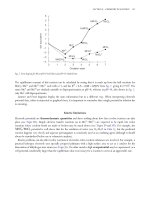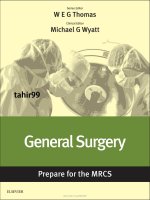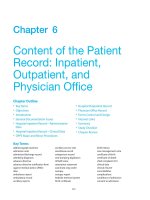Ebook Key notes on plastic surgery (2/E): Part 1
Bạn đang xem bản rút gọn của tài liệu. Xem và tải ngay bản đầy đủ của tài liệu tại đây (2.98 MB, 325 trang )
Key Notes on
Plastic Surgery
Adrian Richards
MBBS, MSc, FRCS (Plast)
Plastic and Cosmetic Surgeon
Aurora Clinics
Princes Risborough
UK
Hywel Dafydd
MB BChir, MA, MSc, FRCS (Plast)
Specialty Registrar
The Welsh Centre for Burns and Plastic Surgery
Morriston Hospital
Swansea
UK
SECOND EDITION
F O R E W O R D B Y P R O F E S S O R F U-C H A N W E I
This edition first published 2015
© 2015 by John Wiley & Sons, Ltd
© 2002 by Blackwell Science Ltd
Registered office:
John Wiley & Sons, Ltd, The Atrium, Southern Gate, Chichester, West Sussex,
PO19 8SQ, UK
Editorial offices:
9600 Garsington Road, Oxford, OX4 2DQ, UK
The Atrium, Southern Gate, Chichester, West Sussex, PO19 8SQ, UK
111 River Street, Hoboken, NJ 07030-5774, USA
For details of our global editorial offices, for customer services and for information about how to apply
for permission to reuse the copyright material in this book please see our website at
www.wiley.com/wiley-blackwell
The right of the author to be identified as the author of this work has been asserted in accordance with
the UK Copyright, Designs and Patents Act 1988.
All rights reserved. No part of this publication may be reproduced, stored in a retrieval system, or
transmitted, in any form or by any means, electronic, mechanical, photocopying, recording or
otherwise, except as permitted by the UK Copyright, Designs and Patents Act 1988, without the prior
permission of the publisher.
Designations used by companies to distinguish their products are often claimed as trademarks. All brand
names and product names used in this book are trade names, service marks, trademarks or registered
trademarks of their respective owners. The publisher is not associated with any product or vendor
mentioned in this book. It is sold on the understanding that the publisher is not engaged in rendering
professional services. If professional advice or other expert assistance is required, the services of a
competent professional should be sought.
The contents of this work are intended to further general scientific research, understanding, and
discussion only and are not intended and should not be relied upon as recommending or promoting a
specific method, diagnosis, or treatment by health science practitioners for any particular patient. The
publisher and the author make no representations or warranties with respect to the accuracy or
completeness of the contents of this work and specifically disclaim all warranties, including without
limitation any implied warranties of fitness for a particular purpose. In view of ongoing research,
equipment modifications, changes in governmental regulations, and the constant flow of information
relating to the use of medicines, equipment, and devices, the reader is urged to review and evaluate the
information provided in the package insert or instructions for each medicine, equipment, or device for,
among other things, any changes in the instructions or indication of usage and for added warnings and
precautions. Readers should consult with a specialist where appropriate. The fact that an organization or
Website is referred to in this work as a citation and/or a potential source of further information does not
mean that the author or the publisher endorses the information the organization or Website may
provide or recommendations it may make. Further, readers should be aware that Internet Websites
listed in this work may have changed or disappeared between when this work was written and when it
is read. No warranty may be created or extended by any promotional statements for this work. Neither
the publisher nor the author shall be liable for any damages arising herefrom.
Library of Congress Cataloging-in-Publication Data
Richards, Adrian M., author.
Key notes on plastic surgery / Adrian Richards, Hywel Dafydd ; foreword by professor Fu-Chan Wei. –
Second edition.
1 online resource.
Includes bibliographical references and index.
Description based on print version record and CIP data provided by publisher; resource not viewed.
ISBN 978-1-118-75686-7 (Adobe PDF) – ISBN 978-1-118-75699-7 (ePub) – ISBN 978-1-4443-3434-0
(pbk.)
I. Dafydd, Hywel, author. II. Title.
[DNLM: 1. Surgery, Plastic. WO 600]
RD119
617.9′ 52 – dc23
2014033321
A catalogue record for this book is available from the British Library.
Wiley also publishes its books in a variety of electronic formats. Some content that appears in print may
not be available in electronic books.
Cover image: © iStock.com/youngvet
Cover design by Andy Meaden
Set in 9.5/12pt Meridien by Laserwords Private Limited, Chennai, India
1
2015
Contents
Foreword
iv
Preface
v
Dedications
vi
Acknowledgements
vi
Abbreviations
vii
1
General Principles
2
Skin and Soft Tissue Lesions
3
The Head and Neck
133
4
The Breast and Chest Wall
264
5
The Upper Limb
309
6
The Lower Limb
422
7
The Trunk and Urogenital System
459
8
Burns
490
9
Aesthetic Surgery
530
Ethics, the Law and Statistics
591
Index
605
10
1
80
iii
Foreword
This second edition of Key Notes on Plastic Surgery distills the breadth and depth of the entire
specialty into a compact format. Clear, concise, accurate and accessible – that is what the
trainee desires when refreshing their memory of conditions during clinic, of reconstructive
algorithms before operating, and of the entire syllabus when preparing for plastic surgery
board examinations. Key Notes on Plastic Surgery fulfils this niche admirably.
A consistent balance has been struck between prose and bullet points throughout the book.
Key Notes on Plastic Surgery fosters understanding, facilitates the commitment of information
to memory, and provides structure to ease the recall of facts and principles. One can rapidly
glean key information with a glance at the page and yet solidify an understanding with a few
minutes’ read. The textual formatting and presentation of information is where this book
particularly shines.
Key Notes on Plastic Surgery will be embraced as a trusted companion by trainees all over the
world as they progress through training and sit for their board examinations. And when they
become established plastic surgeons, Key Notes on Plastic Surgery will take pride of place on
their bookshelves as a reliable quick reference handbook for teaching the next generation.
I highly recommend Key Notes on Plastic Surgery to all aspiring, training and established
plastic surgeons worldwide.
Fu-Chan Wei, MD, FACS
Distinguished Chair Professor
Chang Gung University
Medical College
Taipei, Taiwan
Academician
Academia Sinica
Taiwan
iv
Preface
Hywel Dafydd has updated and improved the first edition of Key Notes on Plastic Surgery.
He has worked tirelessly to include new and better diagrams and improve the content whilst
maintaining the book’s ethos – to succinctly communicate the essentials of Plastic Surgery.
We hope you enjoy the book and find it helpful in making you a better Plastic Surgeon.
Adrian Richards
The first edition of Key Notes has proved to be exceptionally popular for over a decade. Accessible, informative and succinct, it became the preferred handbook for innumerable plastic
surgery trainees. It was typeset with enough ‘white space’ to accommodate trainees’ notes
and sketches as they approached their final plastic surgery examination.
Nevertheless, an update was much-needed: the field of plastic surgery has moved on apace
and a detailed British plastic surgery syllabus was introduced. The material of the first edition has been updated, rewritten and expanded with several new sections to reflect this. In
addition, a new chapter is provided: ‘Ethics and the law’. The number of diagrams has more
than doubled, which should help with learning the ‘essentials’, such as cleft lip repair and
eyelid anatomy. Key Notes is now more complete and, although necessarily larger, remains
true to the format and style of the first edition. We hope that Key Notes continues to be useful
to plastic surgeons worldwide.
Hywel Dafydd
v
Dedications
AR – To my Family, Helena, Josie, Ciara, Alfie and Ned.
HD – For Jenny and Ioan.
Acknowledgements
As any Plastic Surgeon will tell you, the training and practice of the speciality takes dedication
and hard work. Writing a book in your free time adds to this and requires patience and
support from your family. For this reason I would like to thank my family Helena, Josie,
Ciara, Alfie and Ned for their constant support. I would also like to thank my surgical mentors
of whom there were many – in particular Brent Tanner and Michael Klaassen.
Adrian Richards
I would like to thank my wife Jenny and my son Ioan for their love and patience. Jenny also
helped edit final drafts for brevity. Thank you Per Hall for inspiring me to become a plastic
surgeon. Thanks to those who have trained me over the years in Cambridge, Wellington,
Leicester, Birmingham, Coventry, Swansea, Taipei, and Auckland. Special thanks to Sarah
Hemington-Gorse, Ian Josty, Dai Nguyen, Nick Wilson Jones, Tom Potokar, Peter Drew,
Leong Hiew, Hamish Laing, Dean Boyce, Max Murison and Ian Pallister, who spent hours
proofreading early drafts. I am also grateful to Rhidian Dafydd LLB, Karen Wong and Chris
Wallace, who checked much of the text for accuracy. Tom Macleod has been a constant
source of support and encouragement, and did a great deal of preparatory work on many
of the chapters. The book could not have been written without the staff of Morriston Hospital’s library. They sourced over 600 references from three centuries without as much as a
grumble: thank you Anne, Sue, Rita and Lisa.
Hywel Dafydd
vi
Abbreviations
5-FU
ABC
ABPI
AC
ACPA
ACR
ADH
ADM
ADM
AER
AFX
AICAP
AIDS
AIN
AJCC
AK
ALCL
ALH
ALS
ALT
ANOVA
AO
AP
APB
APC
APL
APR
APTT
ARDS
ASIS
ASSH
ATG
ATLS
AVA
AVM
AVN
BAAPS
BAHA
5-fluorouracil
Acinetobacter baumanii-calcoaceticus
ankle brachial pressure index
alternating current
anti-citrullinated protein antibody
American College of Rheumatology
atypical ductal hyperplasia
abductor digiti minimi
acellular dermal matrix
apical ectodermal ridge
atypical fibroxanthoma
anterior intercostal artery perforator (flap)
acquired immune deficiency syndrome
anal intraepithelial neoplasia
American Joint Committee on Cancer
actinic keratosis
anaplastic large T-cell lymphoma
atypical lobular hyperplasia
anti-lymphocyte serum
anterolateral thigh (flap)
analysis of variance
Arbeitsgemeinschaft für Osteosynthesefragen
anteroposterior
abductor pollicis brevis
antigen presenting cell
abductor pollicis longus
abdomino-perineal resection
activated partial thromboplastin time
adult respiratory distress syndrome
anterior superior iliac spine
American Society for Surgery of the Hand
anti-thymoglobulin
Advanced Trauma Life Support
arteriovenous anastomosis
arteriovenous malformation
avascular necrosis
British Association of Aesthetic Plastic Surgeons
bone-anchored hearing aid
vii
viii
Abbreviations
BAPRAS
BAPS
BCC
BDD
BEAM
BMI
BMP
BOA
BPD
BRAF
BRBN
BSA
BSSH
BXO
cAMP
CCNE
CEA
CFNG
CI
CIN
CL
CM
CMCJ
CMN
CNS
CO
COX
CP
CPAP
CPR
CRP
CRPS
CSAG
CSF
CT
CTA
CTLA
CTS
CVP
CVS
DASH
DBD
DC
DCIA
British Association of Plastic, Reconstructive and Aesthetic Surgeons
British Association of Plastic Surgeons
basal cell carcinoma
body dysmorphic disorder
bulbar elongation and anastomotic meatoplasty
body mass index
bone morphogenetic protein
British Orthopaedic Association
biliopancreatic diversion
B-Raf serine/threonine-protein kinase
blue rubber bleb naevus (syndrome)
body surface area
British Society for Surgery of the Hand
balanitis xerotica obliterans
cyclic adenosine monophosphate
Comité Consultatif National d’Ethique
cultured epithelial autograft
cross facial nerve grafting
cranial index
cervical intraepithelial neoplasia
cleft lip
capillary malformation
carpometacarpal joint
congenital melanocytic naevus
central nervous system
carbon monoxide
cyclooxygenase
cleft palate
continuous positive airways pressure
cardiopulmonary resuscitation
C-reactive protein
complex regional pain syndrome
Clinical Standards Advisory Group
cerebrospinal fluid
computed tomography
composite tissue allotransplantation
cytotoxic T-lymphocyte antigen
carpal tunnel syndrome
central venous pressure
cardiovascular system
Disabilities of the Arm, Shoulder and Hand
dermolytic bullous dermatitis
direct current
deep circumflex iliac artery
Abbreviations
DCIS
DD
DEXA
DFAP
DFSP
DICAP
DIEA
DIEP
DIPJ
DIY
DMARD
DNA
DOPA
DOT
DRUJ
DTH
EAST
EBV
ECG
ECRB
ECRL
ECU
EDC
EDM
EGF
EIP
ELND
EEMG
ELD
EMG
EMLA
ENT
EO
EPB
EPL
EPUAP
ER
ERK
ESBL
ESR
EULAR
FAMM
FAMM
FBC
ductal carcinoma in situ
Dupuytren’s disease
dual-energy X-ray absorptiometry
deep femoral artery perforator (flap)
dermatofibrosarcoma protuberans
dorsal intercostal artery perforator (flap)
deep inferior epigastric artery
deep inferior epigastric perforator (flap)
distal interphalangeal joint
do it yourself
disease-modifying antirheumatic drug
deoxyribonucleic acid
dihydroxyphenylalanine
double-opposing tab
distal radio-ulnar joint
delayed type hypersensitivity
elevated arm stress test
Epstein-Barr virus
electrocardiogram
extensor carpi radialis brevis
extensor carpi radialis longus
extensor carpi ulnaris
extensor digitorum communis
extensor digiti minimi
epidermal growth factor
extensor indicis proprius
elective lymph node dissection
evoked electromyography
extended latissimus dorsi (flap)
electromyography
eutetic mixture of local anaesthetic
ear, nose and throat
external oblique
extensor pollicis brevis
extensor pollicis longus
European Pressure Ulcer Advisory Panel
oestrogen receptor
extracellular-signal-regulated kinase
extended-spectrum beta-lactamase
erythrocyte sedimentation rate
European League Against Rheumatism
facial artery musculomucosal (flap)
familial atypical mole and melanoma (syndrome)
full blood count
ix
x
Abbreviations
FCR
FCU
FDA
FDG
FDM
FDMA
FDP
FDS
FFMT
FFP
FGF
FGFR
FIESTA
FISH
FLAIR
FNA
FNAC
FPB
FPL
GAG
GAS
GCS
GI
GLUT1
GMC
GP
Hb
HER
HES
HF
HFS
HIT
HIV
HLA
HMB-45
hMLH1
hMSH2
HPV
HRT
HTA
HU
ICAP
ICD
ICG
flexor carpi radialis
flexor carpi ulnaris
Food and Drug Administration
fluorodeoxyglucose
flexor digiti minimi
first dorsal metacarpal artery (flap)
flexor digitorum profundus
flexor digitorum superficialis
free functioning muscle transfer
fresh frozen plasma
fibroblast growth factor
fibroblast growth factor receptor
fast imaging employing steady-state acquisition
fluorescence in situ hybridisation
fluid attenuated inversion recovery
fine needle aspiration
fine needle aspiration cytology
flexor pollicis brevis
flexor pollicis longus
glycosaminoglycan
group A Streptococcus
Glasgow coma scale
gastro-intestinal
glucose transporter 1
General Medical Council
general practitioner
haemoglobin
human epidermal growth factor receptor
hydroxyethyl starch
hydrofluoric acid
Hannover Fracture Scale
heparin-induced thrombocytopenia
human immunodeficiency virus
human leukocyte antigen
human melanoma black 45
human mutL homolog 1 (gene)
human mutS homolog 2 (gene)
human papilloma virus
hormone replacement therapy
Human Tissue Authority
Hounsfield units
intercostal artery perforator (flap)
intercanthal distance
indocyanine green
Abbreviations
ICP
ICU
IDDM
IFN
IFSSH
IGA
IGAM
IGAP
IHC
IJV
IL
IMF
IMF
IMNAS
INR
IO
IOD
IPJ
IPL
IRG
ISSVA
ITL
ITU
IV
IVF
KA
KTP
KTS
LA
LASER
LCIS
LD
LDH
LDMF
LEAP
LHRH
LICAP
LISN
LM
LM
LME
LMM
LMWH
LRTI
intracranial pressure
intensive care unit
insulin dependent diabetes mellitus
interferon
International Federation of Societies for Surgery of the Hand
inferior gluteal artery
inferior gluteal artery myocutaneous (flap)
inferior gluteal artery perforator (flap)
immunohistochemistry
internal jugular vein
interleukin
inframammary fold
intermaxillary fixation
Institute of Medicine of the National Academy of Science
international normalised ratio
internal oblique
interorbital distance
interphalangeal joint
intense pulsed light
Independent Review Group
International Society for the Study of Vascular Anomalies
inferior temporal line
intensive therapy unit
intravenous
in vitro fertilisation
keratoacanthoma
potassium titanyl phosphate
Klippel-Trénaunay syndrome
local anaesthesia
light amplification by stimulated emission of radiation
lobular carcinoma in situ
latissimus dorsi
lactate dehydrogenase
latissimus dorsi miniflap
Lower Extremity Assessment Project
luteinising hormone releasing hormone
lateral intercostal artery perforator (flap)
lobular in situ neoplasia
lentigo maligna
lymphatic malformation
line of maximum extensibility
lentigo maligna melanoma
low-molecular-weight heparin
ligament reconstruction and tendon interposition
xi
xii
Abbreviations
LSI
LSMDT
MACS
MAGPI
MAL
MAPK
MARIA
MART
MCA
MCC
MCPJ
MDT
MEK
MESS
MFH
MHC
MHRA
MIP
MLD
MM
MMF
MODS
MPNST
MRC
MRI
MRKH
MRND
MRSA
MS
MSG
MSH
MSLT
MSU
MSX2
mTOR
MTPJ
MTT
NAC
NAI
NASHA
NCS
NF
NG
NHS
Limb Salvage Index
local skin cancer multidisciplinary team
Minimal Access Cranial Suspension
meatal advancement and glanuloplasty incorporated
methyl aminolevulinate
mitogen-activated protein kinase
Multistatic Array Processing for Radiowave Image Acquisition
melanoma antigen recognised by T cells
Mental Capacity Act
Merkel cell carcinoma
metacarpophalangeal joint
multidisciplinary team
mitogen/extracellular signal-regulated kinase
Mangled Extremity Severity Score
malignant fibrous histiocytoma
major histocompatibility complex
Medicines and Healthcare Products Regulatory Agency
megameatus intact prepuce
manual lymphatic drainage
malignant melanoma
mandibulomaxillary fixation
multiple organ dysfunction syndrome
malignant peripheral nerve sheath tumour
Medical Research Council
magnetic resonance imaging
Mayer–Rokitansky–Küster–Hauser (syndrome)
modified radical neck dissection
methicillin resistant Staphylococcus aureus
muscle sparing
Melanoma Study Group
melanocyte-stimulating hormone
Multicenter Selective Lymphadenectomy Trial
monosodium urate
msh homeobox 2 (gene)
mammalian target of rapamycin
metatarsophalangeal joint
malignant triton tumour
nipple-areola complex
non-accidental injury
non-animal stabilised hyaluronic acid
nerve conduction studies
neurofibromatosis
nasogastric
National Health Service
Abbreviations
NICH
NK
NOE
NPA
NPI
NPUAP
NPWT
NSAID
NSM
NVB
OA
OGS
OM
OP
ORIF
PA
PAL
PABA
PAF
PCNA
PDE
PDE
PDGF
PDS
PDT
PEEP
PET
PET
PHA
PIN
PIP
PIPJ
PL
PL
PMMA
PMN
POSI
PR
PRPC
PRS
PSI
PSIS
PT
PT
noninvoluting congenital haemangioma
natural killer (cell)
nasoorbitoethmoidal
nasopharyngeal airway
Nottingham Prognostic Index
National Pressure Ulcer Advisory Panel
negative pressure wound therapy
non-steroidal anti-inflammatory drug
nipple sparing mastectomy
neurovascular bundle
osteoarthritis
orthognathic surgery
osteomyelitis
opponens pollicis
open reduction and internal fixation
posteroanterior
power-assisted liposuction
para-amino benzoic acid
platelet activating factor
proliferating cell nuclear antigen (gene)
phosphodiesterase
Photodynamic Eye
platelet-derived growth factor
polydioxanone sulphate
photodynamic therapy
positive end-expiratory pressure
polyethylene terephthalate
positron emission tomography
progressive hemifacial atrophy
posterior interosseous nerve
Poly Implant Prothèse
proximal interphalangeal joint
palmaris longus
phospholipid
polymethylmethacrylate
polymorphonuclear neutrophils
position of safe immobilisation
progesterone receptor
platelet-rich plasma concentrate
Pierre Robin sequence
Predictive Salvage Index
posterior superior iliac spine
prothrombin time
pronator teres
xiii
xiv
Abbreviations
PTCH
PTEN
PTFE
RA
RA
RAPD
RCT
REE
RF
RFAL
RFF
RICH
RND
ROOF
RSTL
SAL
SAN
SCAP
SCC
SCIA
SCM
SEPS
SFS
SGAP
SHH
SIEA
SIRS
SJS
SLE
SLL
SLNB
SMAS
SNAP
SNAP
SND
SNUC
SOOF
SPAIR
SRY
SSD
SSM
SSSS
STIR
STL
patched (gene)
phosphatase and tensin homolog (gene)
polytetrafluoroethylene
rectus abdominis
rheumatoid arthritis
relative afferent pupillary defect
randomised controlled trial
resting energy expenditure
rheumatoid factor
radiofrequency assisted liposuction
radial forearm flap
rapidly involuting congenital haemangioma
radical neck dissection
retro-orbicularis oculi fat (pad)
relaxed skin tension line
suction-assisted liposuction
spinal accessory nerve
syringocystadenoma papilliferum
squamous cell carcinoma
superficial circumflex iliac artery
sternocleidomastoid
subfascial endoscopic perforating vein surgery
superficial fascial system
superior gluteal artery perforator (flap)
sonic hedgehog
superficial inferior epigastric artery (flap)
systemic inflammatory response syndrome
Stevens-Johnson syndrome
systemic lupus erythematosus
scapholunate ligament
sentinel lymph node biopsy
superficial muscular aponeurotic system
sensory nerve action potential
synaptosomal-associated protein
selective neck dissection
sinonasal undifferentiated carcinoma
suborbicularis oculi fat (pad)
short scar periareolar inferior pedicle reduction
sex-determining region of the Y chromosome
silver sulfadiazine
skin sparing mastectomy
staphylococcal scalded skin syndrome
short T1 inversion recovery
superior temporal line
Abbreviations
STS
STT
TA
TAM
TAR
TB
TBSA
TCA
TDA
TDAP
TED
TEN
TF
TFL
TGF
TIMP
TIP
TMJ
TNF
TNM
TNMG
TOS
t-PA
TPN
TRAM
TRT
TSS
TSST
TUG
TWIST
UAL
UCL
UK
USA
USP
UV
USS
VAIN
VASER
VCA
VEGF
VEGFR
VF
VIN
soft tissue sarcoma
scaphotrapezium-trapezoid
transversus abdominis
total active motion
thrombocytopenia – absent radius (syndrome)
tubercle bacillus
total body surface area
trichloroacetic acid
toluene diamine
thoracodorsal artery perforator
thromboembolic device
toxic epidermal necrolysis
tissue factor
tensor fasciae latae
transforming growth factor
tissue inhibitor of metalloproteinase
tubularised incised plate
temporomandibular joint
tumour necrosis factor
tumour, nodes, metastasis
tumour, nodes, metastasis, grade
thoracic outlet syndrome
tissue plasminogen activator
total parenteral nutrition
transverse rectus abdominis myocutaneous (flap)
thermal relaxation time
toxic shock syndrome
toxic shock syndrome toxin
transverse upper gracilis
twist family basic helix-loop-helix transcription factor (gene)
ultrasound-assisted liposuction
ulnar collateral ligament
United Kingdom
United States of America
United States Pharmacopeia
ultraviolet
ultrasound scan
vaginal intraepithelial neoplasia
Vibration Amplification of Sound Energy at Resonance
vascularised composite allotransplantation
vascular endothelial growth factor
vascular endothelial growth factor receptor
ventricular fibrillation
vulval intraepithelial neoplasia
xv
xvi
Abbreviations
VM
VMCM
VPI
VRAM
VRE
vWF
WHO
WLE
WNT7A
XP
YAG
ZF
ZM
ZPA
venous malformation
multiple cutaneous and mucosal venous malformations
velopharyngeal insufficiency
vertical rectus abdominis myocutaneous (flap)
vancomycin resistant Enterococcus
von Willebrand factor
World Health Organisation
wide local excision
wingless-type MMTV integration site family, member 7A
xeroderma pigmentosa
yttrium aluminium garnet
zygomaticofrontal
zygomaticomaxillary
zone of polarising activity
CHAPTER 1
General Principles
CHAPTER CONTENTS
Embryology, structure and function of the skin, 1
Blood supply to the skin, 5
Classification of flaps, 9
Geometry of local flaps, 13
Wound healing and skin grafts, 22
Bone healing and bone grafts, 31
Cartilage healing and cartilage grafts, 35
Nerve healing and nerve grafts, 36
Tendon healing, 41
Transplantation, 42
Tissue engineering, 47
Alloplastic implantation, 48
Wound dressings, 53
Sutures and suturing, 55
Tissue expansion, 57
Lasers, 61
Local anaesthesia, 65
Microsurgery, 69
Haemostasis and thrombosis, 74
Further reading, 77
Embryology, structure and function of the skin
• Skin differentiates from ectoderm and mesoderm during the 4th week.
• Skin gives rise to:
∘ Teeth and hair follicles, derived from epidermis and dermis
∘ Fingernails and toenails, derived from epidermis only.
• Hair follicles, sebaceous glands, sweat glands, apocrine glands and mammary glands are
‘epidermal appendages’ because they develop as ingrowths of epidermis into dermis.
• Functions of skin:
1 Physical protection
2 Protection against UV light
3 Protection against microbiological invasion
4 Prevention of fluid loss
Key Notes on Plastic Surgery, Second Edition. Adrian Richards and Hywel Dafydd.
© 2015 John Wiley & Sons, Ltd. Published 2015 by John Wiley & Sons, Ltd.
1
2
Chapter 1
5 Regulation of body temperature
6 Sensation
7 Immunological surveillance.
Epidermis
Papillary dermis
Reticular dermis
Subcutaneous tissue
Arrector pili muscle
Sebaceous gland
Hair bulb
Eccrine sweat gland
The epidermis
• Composed of stratified squamous epithelium.
• Derived from ectoderm.
• Epidermal cells undergo keratinisation – their cytoplasm is replaced with keratin as the
cell dies and becomes more superficial.
• Rete ridges are epidermal thickenings that extend downward between dermal papillae.
• Epidermis is composed of these five layers, from deep to superficial:
1 Stratum germinativum
∘ Also known as the basal layer.
∘ Cells within this layer have cytoplasmic projections (hemidesmosomes), which firmly
link them to the underlying basal lamina.
∘ The only actively proliferating layer of skin.
∘ Stratum germinativum also contains melanocytes.
2 Stratum spinosum
∘ Also known as the prickle cell layer.
∘ Contains large keratinocytes, which synthesise cytokeratin.
∘ Cytokeratin accumulates in aggregates called tonofibrils.
∘ Bundles of tonofibrils converge into numerous desmosomes (prickles), forming strong
intercellular contacts.
3 Stratum granulosum
∘ Contains mature keratinocytes, with cytoplasmic granules of keratohyalin.
∘ The predominant site of protein synthesis.
∘ Combination of cytokeratin tonofibrils with keratohyalin produces keratin.
4 Stratum lucidum
∘ A clear layer, only present in the thick glabrous skin of palms and feet.
General Principles
3
5 Stratum corneum
∘ Contains non-viable keratinised cells, having lost their nuclei and cytoplasm.
∘ Protects against trauma.
∘ Insulates against fluid loss.
∘ Protects against bacterial invasion and mechanical stress.
Cellular composition of the epidermis
• Keratinocytes – the predominant cell type in the epidermis.
• Langerhans cells – antigen-presenting cells (APCs) of the immune system.
• Merkel cells – mechanoreceptors of neural crest origin.
• Melanocytes – neural crest derivatives:
∘ Usually located in the stratum germinativum.
∘ Produce melanin packaged in melanosomes, which is delivered along dendrites to
surrounding keratinocytes.
∘ Melanosomes form a cap over the nucleus of keratinocytes, protecting DNA from
UV light.
The dermis
Accounts for 95% of the skin’s thickness.
Derived from mesoderm.
Papillary dermis is superficial; contains more cells and finer collagen fibres.
Reticular dermis is deeper; contains fewer cells and coarser collagen fibres.
It sustains and supports the epidermis.
Dermis is composed of:
Collagen fibres
∘ Produced by fibroblasts.
∘ Through cross-linking, are responsible for much of the skin’s strength.
∘ The normal ratio of type 1 to type 3 collagen is 5:1.
2 Elastin fibres
∘ Secreted by fibroblasts.
∘ Responsible for elastic recoil of skin.
3 Ground substance
∘ Consists of glycosaminoglycans (GAGs): hyaluronic acid, dermatan sulphate, chondroitin sulphate.
∘ GAGs are secreted by fibroblasts and become ground substance when hydrated.
4 Vascular plexus
∘ Separates the denser reticular dermis from the overlying papillary dermis.
•
•
•
•
•
•
1
Skin appendages
Hair follicles
• Each hair is composed of a medulla, a cortex and an outer cuticle.
• Hair follicles consist of an inner root sheath (derived from epidermis), and an outer root
sheath (derived from dermis).
4
Chapter 1
• Several sebaceous glands drain into each follicle.
∘ Drainage of the glands is aided by contraction of arrector pili muscles.
• Vellus hairs are fine and downy; terminal hairs are coarse.
• Hairs are either in anagen (growth), catagen (regressing), or telogen (resting) phase.
∘ <90% are in anagen, 1–2% in catagen and 10–14% in telogen at any one time.
Eccrine glands
• These sweat glands secrete odourless hypotonic fluid.
• Present in almost all sites of the body.
• Occur more frequently in the palm, sole and axilla.
Apocrine glands
• Located in axilla and groin.
• Emit a thicker secretion than eccrine glands.
• Responsible for body odour; do not function before puberty.
• Modified apocrine glands are found in the external ear (ceruminous glands) and eyelid
(Moll glands).
• The mammary gland is a modified apocrine gland specialised for manufacture of colostrum
and milk.
• Hidradenitis suppurativa is a disease of apocrine glands.
Sebaceous glands
• Holocrine glands that drain into the pilosebaceous unit in hair-bearing skin.
• They drain directly onto skin in the labia minora, penis and tarsus (meibomian glands).
• Most prevalent on forehead, nose and cheek; absent from palms and soles.
• Produce sebum, which contains fats and their breakdown products, wax esters and debris
of dead fat-producing cells.
∘ Sebum is bactericidal to staphylococci and streptococci.
• Sebaceous glands are not the sole cause of so-called sebaceous cysts.
• These cysts are in fact of epidermal origin and contain all substances secreted by skin
(predominantly keratin).
∘ Some maintain they should therefore be called epidermoid cysts.
Types of secretion from glands
• Eccrine or merocrine glands secrete opened vesicles via exocytosis.
• Apocrine glands secrete by ‘membrane budding’ – pinching off part of the cytoplasm in
vesicles bound by the cell’s own plasma membrane.
• Holocrine gland secretions are produced within the cell, followed by rupture of the cell’s
plasma membrane.
Histological terms
• Acanthosis: epidermal hyperplasia.
• Papillomatosis: increased depth of corrugations at the dermoepidermal junction.
• Hyperkeratosis: increased thickness of the keratin layer.
General Principles
5
• Parakeratosis: presence of nucleated cells at the skin surface.
• Pagetoid: when cells invade the upper epidermis from below.
• Palisading: when cells are oriented perpendicular to a surface.
Blood supply to the skin
• Epidermis contains no blood vessels.
• It is dependent on dermis for nutrients, supplied by diffusion.
Anatomy of the circulation
• Blood reaching the skin originates from named deep vessels.
• These feed interconnecting vessels, which supply the vascular plexuses of fascia, subcutaneous tissue and skin.
Deep vessels
• Arise from the aorta and divide to form the main arterial supply to head, neck, trunk
and limbs.
Interconnecting vessels
• The interconnecting system is composed of:
∘ Fasciocutaneous (or septocutaneous) vessels
– Reach the skin directly by traversing fascial septa.
– Provide the main arterial supply to skin in the limbs.
• Musculocutaneous vessels
∘ Reach the skin indirectly via muscular branches from the deep system.
∘ These branches enter muscle bellies and divide into multiple perforating branches,
which travel up to the skin.
∘ Provide the main arterial supply to skin of the torso.
Vascular plexuses of fascia, subcutaneous tissue and skin
1 Subfascial plexus
∘ Small plexus lying on the undersurface of deep fascia.
2 Prefascial plexus
∘ Larger plexus superficial to deep fascia; prominent on the limbs.
∘ Predominantly supplied by fasciocutaneous vessels.
3 Subcutaneous plexus
∘ At the level of superficial fascia.
∘ Mainly supplied by musculocutaneous vessels.
∘ Predominant on the torso.
4 Subdermal plexus
∘ Receives blood from the underlying plexuses.
∘ The main plexus supplying blood to skin.
∘ Accounts for dermal bleeding observed in incised skin.
6
Chapter 1
5 Dermal plexus
∘ Mainly composed of arterioles.
∘ Plays an important role in thermoregulation.
6 Subepidermal plexus
∘ Contains small vessels without muscle in their walls.
∘ Predominantly nutritive and thermoregulatory function.
Angiosomes
•
•
•
•
•
•
•
•
An angiosome is a three-dimensional composite block of tissue supplied by a named artery.
The area of skin supplied by an artery was first studied by Manchot in 1889.
His work was expanded by Salmon in the 1930s, and more recently by Taylor and Palmer.
The anatomical territory of an artery is the area into which the vessel ramifies before
anastomosing with adjacent vessels.
The dynamic territory of an artery is the area into which staining extends after intravascular infusion of fluorescein.
The potential territory of an artery is the area that can be included in a flap if it is delayed.
Vessels that pass between anatomical territories are called choke vessels.
The transverse rectus abdominis myocutaneous (TRAM) flap illustrates the angiosome
concept well:
Zone 1
• Receives musculocutaneous perforators from the deep inferior epigastric artery (DIEA)
and is therefore in its anatomical territory.
Zones 2 and 3
• There is controversy as to which of the following zones is 2 and which is 3.
• Hartrampf’s 1982 description has zone 2 across the midline and zone 3 lateral to zone 1.
∘ Holm’s 2006 study shows the opposite to be true.
• Skin lateral to zone 1 is in the anatomical territory of the superficial circumflex iliac artery
(SCIA).
∘ Blood has to travel through a set of choke vessels to reach it from the ipsilateral DIEA.
• Skin on the contralateral side of the linea alba is in the anatomical area of the ipsilateral
DIEA.
∘ It is also within the dynamic territory of the contralateral DIEA.
∘ This allows a TRAM flap to be reliably perfused based on either DIEA.
Zone 4
• This lies furthest from the pedicle and is in the anatomical territory of the contralateral
SCIA.
• Blood passing from the pedicle to zone 4 has to cross two sets of choke vessels.
• This portion of the TRAM flap has the worst blood supply and is often discarded.
Arterial characteristics
• Taylor made the following observations from his detailed anatomical dissections:
∘ Vessels usually travel with nerves.
∘ Vessels obey the law of equilibrium – if one is small, its neighbour will tend to be large.
General Principles
∘
∘
∘
7
Vessels travel from fixed to mobile tissue.
Vessels have a fixed destination but varied origin.
Vessel size and orientation is a product of growth.
Venous characteristics
• Venous networks consist of linked valvular and avalvular channels that allow equilibrium
of flow and pressure.
• Directional veins are valved; typically found in subcutaneous tissues of limbs or as a stellate
pattern of collecting veins.
• Oscillating avalvular veins allow free flow between valved channels of adjacent venous
territories.
∘ They mirror and accompany choke arteries.
∘ They define the perimeter of venous territories in the same way choke arteries define
arterial territories.
• Superficial veins follow nerves; perforating veins follow perforating arteries.
The microcirculation
• Terminal arterioles are found in reticular dermis.
∘ They terminate as they enter the capillary network.
• The precapillary sphincter is the last part of the arterial tree containing muscle within its
wall.
∘ It is under neural control and regulates blood flow into the capillary network.
• The skin’s blood supply far exceeds its nutritive requirements.
• It bypasses capillary beds via arteriovenous anastomoses (AVAs) and has a primarily thermoregulatory function.
∘ AVAs connect arterioles to efferent veins.
• AVAs are of two types:
1 Indirect AVAs – convoluted structures known as glomera (sing. glomus)
– Densely innervated by autonomic nerves.
2 Direct AVAs – less convoluted with sparser autonomic supply.
Control of blood flow
• The muscular tone of vessels is controlled by:
Pressure of the blood within vessels (myogenic theory)
• Originally described by Bayliss, states that:
∘ Increased intraluminal pressure results in constriction of vessels.
∘ Decreased intraluminal pressure results in their dilatation.
• Helps keep blood flow constant; accounts for hyperaemia on release of a tourniquet.
Neural innervation
• Arterioles, AVAs and precapillary sphincters are sympathetically innervated.
• Increased arteriolar tone results in decreased cutaneous blood flow.
• Increased precapillary sphincter tone reduces blood flow into capillary networks.
• Decreased AVA tone increases non-nutritive blood flow bypassing the capillary bed.
8
Chapter 1
Humoral factors
• Epinephrine, norepinephrine, serotonin, thromboxane A2 and prostaglandin F2α cause
vasoconstriction.
• Histamine, bradykinin and prostaglandin E1 cause vasodilatation.
• Low O2 saturation, high CO2 saturation and acidosis also cause vasodilatation.
Temperature
• Heat causes cutaneous vasodilatation and increased flow, which predominantly bypasses
capillary beds via AVAs.
The delay phenomenon
• Delay is any preoperative manoeuvre that results in increased flap survival.
• Historical examples include Tagliacozzi’s nasal reconstruction described in the 16th
century.
∘ Involves elevation of a bipedicled flap with length : breadth ratio of 2:1.
∘ The flap can be considered as two 1:1 flaps.
∘ Cotton lint is placed under the flap, preventing its reattachment.
∘ Two weeks later, one end of the flap is detached from the arm and attached to the nose.
– A flap of these dimensions transferred without a delay procedure would have a significant chance of distal necrosis.
• Delay is occasionally used for pedicled TRAM breast reconstruction.
∘ The DIEA is ligated two weeks prior to flap transfer.
• The mechanism of delay remains incompletely understood.
• These theories have been proposed to explain the delay phenomenon:
Increased axiality of blood flow
• Removal of blood flow from the periphery of a random flap promotes development of an
axial blood supply from its base.
• Axial flaps have improved survival compared to random flaps.
Tolerance to ischaemia
• Cells become accustomed to hypoxia after the initial delay procedure.
• Less tissue necrosis therefore occurs after the second operation.
Sympathectomy vasodilatation theory
• Dividing sympathetic fibres at the borders of a flap results in vasodilatation and improved
blood supply.
• But why, if sympathectomy is immediate, does the delay phenomenon only begin to
appear at 48 hours, and why does it take 2 weeks for maximum effect?
Intraflap shunting hypothesis
• Postulates that sympathectomy dilates AVAs, resulting in an increase in nonnutritive blood
flow bypassing the capillary bed.
• A greater length of flap will survive at the second stage as there are fewer sympathetic
fibres to cut and therefore less of a reduction in nutritive blood flow.









